AND MORE …
This is our catch-all page, where you will find some added information and a few odds and ends that may be helpful or interesting.
PRODUCT AVAILABILITY
Aside from mail orders, Georgia's products are also available in Chester, California at FOREVER HOME, a wonderful shop located at 212 Main Street (Hwy 36) on the east side of downtown Chester, next to the Elks Lodge.
THE WEAVING PROCESS
Here's a quick look at the basic sequence of steps involved in weaving something as "simple" as a tea towel.
1. The process begins with the selection of the yarn for the project. For tea towels, Georgia uses 5/2 cotton yarn, unmercerized natural for the field and mercerized colored yarn for the accents. The amount (length) of yarn needed for the project is calculated and the appropriate yarns are selected.
2. The yarn comes from the supplier on cones. If you look carefully at the first photograph you will see some cones on the shelves in the background. To get the proper lengths needed for the warp threads on the loom, the yarn is measured off the cone using a warping wheel, the item in the foreground of the photo. A guide thread (the thin red line in the photo) is wound in a spiral path around the wheel to assist in the measuring process.
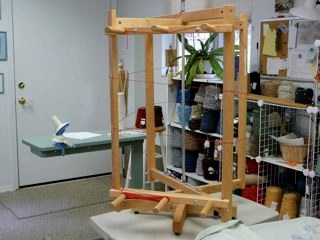
3. The warping wheel is turned by hand as the yarn is would in a spiral path to achieve the desired individual thread lengths. To process continues, back and forth, until all of the needed warp threads have been measured off. For a normal batch of tea towels, about 270 individual threads are needed.
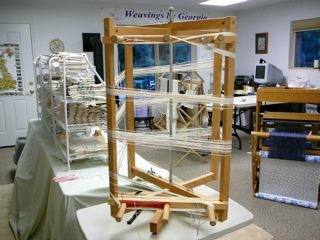
4. Groups of measured threads, called warp chains, are placed on the loom pin preparation for loading. The plain and colored threads are separated according to the warp pattern that will be used in the weaving.
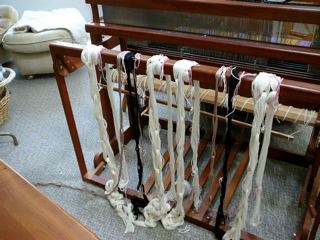
5. The threads are then fed through the reed, one thread at a time, matching the color sequence of the tea towel pattern.
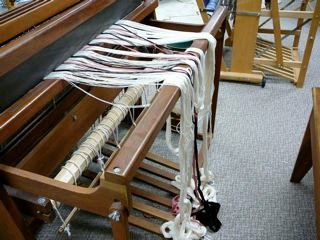
The reed maintains the warp spacing at so many threads per inch.
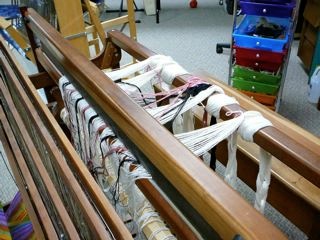
6. Next, the threads are individually fed through heddles, again in proper sequence. During weaving the heddles move up and down, lifting threads in an alternating pattern to achieve the desired woven structure of the fabric. The weaver uses her feet to press on long wooden treadles that cause the heddles to rise and fall.
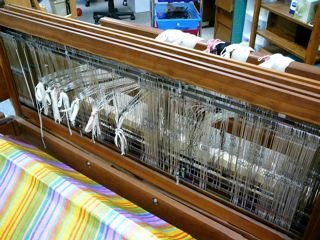
7. After passing through the (stationary) reed and (moving) heddles, the threads are secured at each end. On the back side of the loom the threads are tied off to the back beam. On the front (the "working side" of the loom) the threads are tied off to the fabric beam. This must be done carefully to ensure even tension on all of the warp threads.
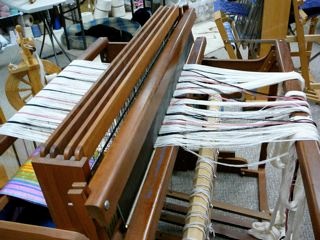
8. Yarn is also would onto long pirns that are loaded into shuttles, carrying the weft threads back and forth across the loom. The initial few lines of weft here are done with light rope as a means of getting the warp threads stabilized before starting the finish weft.
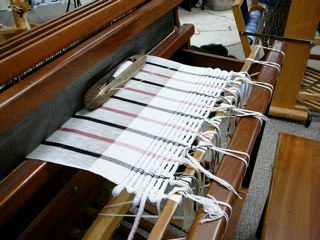
9. Once the weft gets underway it's a matter of working back and forth until the desired length of fabric has been achieved. Warp threads are the "long" threads attached to the loom, while weft threads are the "back and forth" threads coming out of the shuttle. The colored accents are woven in at regular intervals using a separate shuttle loaded with colored thread. Multiple team towels are typically woven in a single continuous run.
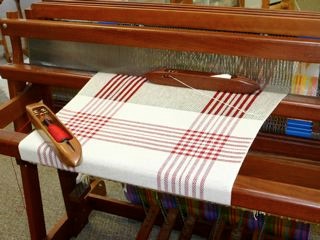
10. Of course, more remains to be done after the fabric is woven on the loom. The material is removed from the loom, washed and dried (which sets the weave and softens the material considerably). The individual tea towels are then cut and hemmed. After a label is attached, they are finally ready.
WHERE THE HECK IS LAKE ALMANOR & CHESTER?
Hidden away in the northeastern portion of California, in an area that was simply described as "unexplored country" on Gold Rush era maps, there lies a quiet land that is full of natural beauty. Here the ancient Sierra Nevada rocks meet the "young" volcanics of the Cascades in a setting that is a mix of mountains, forests, meadows, rivers and lakes.
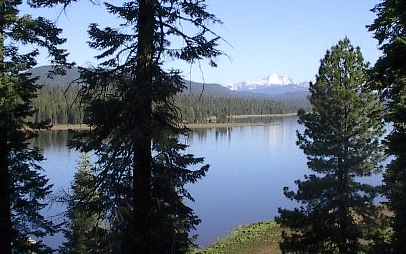
Lake Almanor itself is a relatively recent addition to the landscape, having been formed as a reservoir in 1914. The 44 square mile lake is at the headwaters end of the extensive Feather River hydroelectric power system. The lake and the several small communities and residential developments that border it are located between Red Bluff on the west and Susanville on the east, at an elevation of approximately 4,500 feet above sea level.

Lake Almanor and its principal town of Chester are in northern Plumas County, itself a completely rural jurisdiction with a county population of less than 20,000. It's a region with limited industry and very light population density, but boundless opportunities for do-it-yourself outdoor recreation and artistic creativity. Residents must, however, be willing to forego nearby shopping malls and most other urban conveniences or creature comforts. They must also be able to cope with the rigors of winter snowstorms and occasional warm season wildfires.
